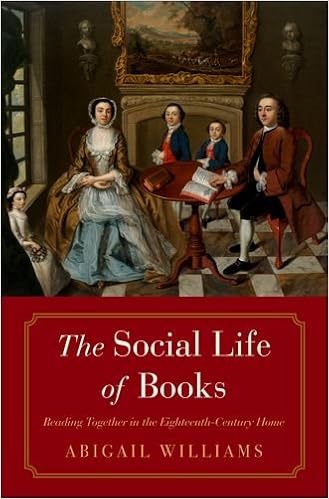Reading as a Social Activity
Abigail Williams—
On 15 April 1802, Dorothy and William Wordsworth took one of the most significant walks in literary history. They set out in blustery weather, across the fells near Ullswater in the Lake District. It was misty and mild, with a strong wind, and the first signs of spring were emerging in the hedgerows. Passing Gowbarrow Park, they saw a few wild daffodils, and then as they walked along, they discovered a whole belt of them, almost as broad as a road. Dorothy’s journal entry reads:
“I never saw daffodils so beautiful they grew among the mossy stones about & about them, some rested their heads upon these stones as on a pillow for weariness & the rest tossed & reeled & danced & seemed as if they verily laughed with the wind that blew upon them over the Lake, they looked so gay ever glancing ever changing.”
Brother and sister continued their walk and later found refuge in a tavern, where they enjoyed a robust meal of ham and potatoes. After supper, Dorothy recounts: “William was sitting by a bright fire when I came downstairs. He soon made his way to the Library piled up in a corner of the window. He brought out a volume of Enfield’s Speaker, another miscellany, & an odd volume of Congreve’s plays. We had a glass of warm rum & water—we enjoyed ourselves & wished for Mary.”
There is much to say about this record of a day. Dorothy’s diary entry, fuller than the extract quoted here, was to provide the basis for her brother’s more celebrated poem “I wandered lonely as a cloud,” written two years later, in which he describes the daffodils as joyful companions to a solitary poet-walker. The poem became perhaps the most famous lyric in English literature, the embodiment of the romantic celebration of imagination and nature. Dorothy’s diary, on the other hand, is less known outside academic circles. What is also striking is that the poem and the diary represent two very different kinds of literary activity. In writing about the daffodils, Wordsworth emphasised the solipsistic aspect of his experience: the solitary, absorptive, silent nature of imagination, and the images that “flash upon the inward eye.” But his sister’s journal entry, behind that poem, records the mutual enjoyment of the walk and its daffodils, and it ends, significantly, with communal domestic entertainment. Brother and sister sit by the fire in a tavern after a long day out, taking down random popular collections of verse and drama from the shelves, and reading them aloud together over a glass of rum before bed. Dorothy’s version, written in a diary that she often read aloud to her brother, is a story about shared experience.
William Wordsworth and other romantic writers were hugely influential in shaping a model of poetry and literature as a form of individual self-expression, and reading as a source of personal inspiration and self-discovery. For centuries before and since them, poets, artists, and philosophers have, in one historian’s words, “limned their aloneness,” emphasizing the role of solitude in the creation of culture and knowledge. But communal reading and literary activity have been an equally important part of our cultural history. What might we learn if we dwelt a bit longer on Dorothy Wordsworth’s account of her day of walking and reading? Was their experience shared or singular? Was enjoying a book together the same as doing it alone? These questions reverberate throughout the history of sociable reading. The episode illuminates how the appreciation of a work could be shaped by the practical settings within which it was enjoyed—in this case, the valuing of “an odd volume” of Congreve’s plays is less about its content, and more about the circumstances in which it is read, over a glass of warm rum, with a loved one, after a memorable day out. We see the whimsical, happenstance nature of literary choices: the Wordsworths take down whatever they find on the shelves of the tavern, and it serves an end, for an evening—it is not a carefully thought out programme of intellectual improvement. What is read is less important than how. The story also illustrates the role of compilations: the other book that Dorothy names, William Enfield’s The Speaker, was one of the most popular collections of the time, a selection of verse and prose originally aimed at the moral and social improvement of the young, but which came to be used in many homes as a familiar assortment of readable extracts to while away an afternoon or evening in company. Dorothy’s example of shared reading offers us a literary experience in which place, company, food, drink, and accessibility all play an important part.
A history of sociable reading puts books back into lives and homes, enabling us to see literature in the round. Hairdressing, carriage rides, and stuttering children all play a part in its story. We can see the way readers’ hopes, choices, constraints, and concerns form part of the history of meanings of the book we hold before us three centuries later. It highlights how certain practical and cultural contexts—limited lighting, rudimentary ophthalmology, increased leisure time, desire for the display of polite knowledge—affected the ways in which books were consumed. It also enables us to understand better some of the particularities of the literary history of the era. Sometimes reading together was a preventative measure—particularly in the case of newly fashionable prose fiction, which was widely represented as dangerously titillating. The eroticised solitary female reader depicted in Auguste Bernard d’Agesci’s painting Lady Reading the Letters of Heloise and Abelard evokes powerfully the perceived seductions of fiction that accompanied the heated debates over the rise of the novel. In fact, she is probably not a reliable representation of the average eighteenth-century novel reader, who, according to some recent book historians, was more likely to have been a respectable middle-aged man. But we can see in her an image of the moral laxity that could stem from ungoverned fiction reading. Sociable reading could be a corrective to such habits, enabling parents to regain some control over the reading lives of their household, and to guide the young and morally vulnerable towards more appropriate forms of literature.
From The Social Life of Books by Abigail Williams. Published by Yale University Press in 2019. Reproduced with permission.
Abigail Williams is Lord White Fellow and Professor of Eighteenth-Century Studies at St. Peter’s College, University of Oxford.
Further Reading:



























